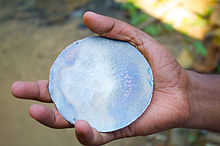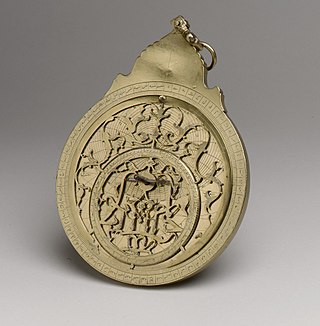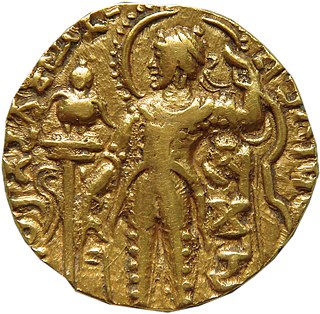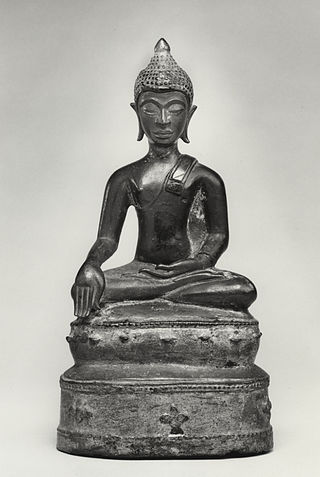



Aranmula Kannadi, meaning the Aranmula mirror, is a handmade, metal-alloy, first surface mirror made in Aranmula, a small town in Pathanamthitta in the state of Kerala, India.




Aranmula Kannadi, meaning the Aranmula mirror, is a handmade, metal-alloy, first surface mirror made in Aranmula, a small town in Pathanamthitta in the state of Kerala, India.
Unlike normal "silvered" glass mirrors, it is a metal-alloy mirror or first surface mirror or front surface reflection mirror, which eliminates secondary reflections and aberrations typical of back surface mirrors. They are produced by one extended family in Aranmula. The exact metals used in the alloy are maintained as family secrets; metallurgists suggest that the alloy is a mix of copper and tin, [1] so a type of speculum metal, counting as a bronze mirror. It is polished for several days to achieve the mirror's reflective surface. [2] The polishing is done using an abrasive paste made by mixing rice bran with oil extracted from seeds of maroṭṭi ( Hydnocarpus pentandrus ). [3]
The origins of the Aranmula kannadi are linked to Aranmula Parthasarathy Temple. According to legend, centuries ago the royal chief brought eight families of temple artisans and craftsmen from Tirunelveli district in Tamil Nadu to Aranmula to create the mirrors in the temple.
These unique mirrors are the result of then Kerala's rich cultural and metallurgical traditions. They have great historical and cultural value, and are thought to bring good luck. [2] The mirrors are considered one of the eight auspicious items or "ashtamangalyam" used in the entry of a bride at a wedding venue. [4] [1] Chief minister of Kerala Pinarayi Vijayan presented an Aranmula mirror to King Hamad of Bahrain during a visit there in 2017.
The British Museum in London has an Aranmula mirror 45 centimeters tall in its collection. [2] The mirrors received a geographical indication (GI) tag in 2004-05. [5]

An alloy is a mixture of chemical elements of which in most cases at least one is a metallic element, although it is also sometimes used for mixtures of elements; herein only metallic alloys are described. Most alloys are metallic and show good electrical conductivity, ductility, opacity, and luster, and may have properties that differ from those of the pure elements such as increased strength or hardness. In some cases, an alloy may reduce the overall cost of the material while preserving important properties. In other cases, the mixture imparts synergistic properties such as corrosion resistance or mechanical strength.

Brass is an alloy of copper and zinc, in proportions which can be varied to achieve different colours and mechanical, electrical, acoustic and chemical properties, but copper typically has the larger proportion, generally 66% copper and 34% zinc. In use since prehistoric times, it is a substitutional alloy: atoms of the two constituents may replace each other within the same crystal structure.

Bronze is an alloy consisting primarily of copper, commonly with about 12–12.5% tin and often with the addition of other metals and sometimes non-metals, such as phosphorus, or metalloids, such as arsenic or silicon. These additions produce a range of alloys that may be harder than copper alone, or have other useful properties, such as strength, ductility, or machinability.

Metallurgy is a domain of materials science and engineering that studies the physical and chemical behavior of metallic elements, their inter-metallic compounds, and their mixtures, which are known as alloys.

A mirror, also known as a looking glass, is an object that reflects an image. Light that bounces off a mirror will show an image of whatever is in front of it, when focused through the lens of the eye or a camera. Mirrors reverse the direction of the image in an equal yet opposite angle from which the light shines upon it. This allows the viewer to see themselves or objects behind them, or even objects that are at an angle from them but out of their field of view, such as around a corner. Natural mirrors have existed since prehistoric times, such as the surface of water, but people have been manufacturing mirrors out of a variety of materials for thousands of years, like stone, metals, and glass. In modern mirrors, metals like silver or aluminium are often used due to their high reflectivity, applied as a thin coating on glass because of its naturally smooth and very hard surface.

Wootz steel is a crucible steel characterized by a pattern of bands and high carbon content. These bands are formed by sheets of microscopic carbides within a tempered martensite or pearlite matrix in higher-carbon steel, or by ferrite and pearlite banding in lower-carbon steels. It was a pioneering steel alloy developed in southern India in the mid-1st millennium BC and exported globally.

Speculum metal is a mixture of around two-thirds copper and one-third tin, making a white brittle alloy that can be polished to make a highly reflective surface. It was used historically to make different kinds of mirrors from personal grooming aids to optical devices until it was replaced by more modern materials such as metal-coated glass mirrors.

Bell metal or bell bronze is an alloy used for making bells and related instruments, such as cymbals. It is a form of bronze with a higher tin content than most other bronzes, usually in approximately a 4:1 ratio of copper to tin. The higher tin content increases the rigidity of the metal, and increases the resonance. Historically, it was preferred for early cannons. Today, it also has industrial uses, being specified for valve bodies, piston rings, bearings, and bushings.

The history of metallurgy in the Indian subcontinent began prior to the 3rd millennium BCE. Metals and related concepts were mentioned in various early Vedic age texts. The Rigveda already uses the Sanskrit term ayas. The Indian cultural and commercial contacts with the Near East and the Greco-Roman world enabled an exchange of metallurgic sciences. The advent of the Mughals further improved the established tradition of metallurgy and metal working in India. During the period of British rule in India, the metalworking industry in India stagnated due to various colonial policies, though efforts by industrialists led to the industry's revival during the 19th century.

Pathanamthitta, is a municipality situated in the Southern Kerala, India, spread over an area of 23.50 km2. It is the administrative capital of Pathanamthitta district. The town has a population of 37,538. The Hindu pilgrim centre Sabarimala is situated in the Pathanamthitta district; as the main transport hub to Sabarimala, the town is known as the 'Pilgrim Capital of Kerala'. Pathanamthitta District, the thirteenth revenue district of the State of Kerala, was formed with effect from 1 November 1982, with headquarters at Pathanamthitta. Forest covers more than half of the total area of the District. Pathanamthitta District ranks the 7th in area in the State. The district has its borders with Allepey, Kottayam, Kollam and Idukki districts of Kerala and Tamil Nadu. Nearest town is Thiruvalla, located at a distance of 30 km. Thiruvalla railway station is 30 km via Thiruvalla-Kumbazha highway.

Bronze mirrors preceded the glass mirrors of today. This type of mirror, sometimes termed a copper mirror, has been found by archaeologists among elite assemblages from various cultures, from Etruscan Italy to Japan. Typically they are round and rather small, in the West with a handle, in East Asia with a knob to hold at the back, often with a loop for a cord, or silk tassel. Some were fitted with small stands, and others had a hinged protective cover. In surviving ancient examples the surface is too corroded to be reflective, but some bronze mirrors are still made.

Arsenical bronze is an alloy in which arsenic, as opposed to or in addition to tin or other constituent metals, is combined with copper to make bronze. The use of arsenic with copper, either as the secondary constituent or with another component such as tin, results in a stronger final product and better casting behavior.

The Aranmula Parthasarathy Temple is a Hindu temple located in Aranmula, a village in Pathanamthitta District, Kerala, South India, on the southern bank of Pamba river, the third longest river in Kerala. It is dedicated to the Lord Krishna, who is worshipped as Parthasarathy. Constructed in the Kerala style of architecture, it is one of the "Divya Desams", the 108 temples of Vishnu revered by the Alvar saints.
Bismuth bronze or bismuth brass is a copper alloy which typically contains 1-3% bismuth by weight, although some alloys contain over 6% Bi. This bronze alloy is very corrosion-resistant, a property which makes it suitable for use in environments such as the ocean. Bismuth bronzes and brasses are more malleable, thermally conductive, and polish better than regular brasses. The most common industrial application of these metals is as bearings, however the material has been in use since the late nineteenth century as kitchenware and mirrors. Bismuth bronze was also found in ceremonial Inca knives at Machu Picchu. Recently, pressure for the substitution of hazardous metals has increased and with it bismuth bronze is being marketed as a green alternative to leaded bronze bearings and bushings.
Sharada SrinivasanFRAS FAAAS is an archaeologist specializing in the scientific study of art, archaeology, archaeometallurgy and culture. She is a professor at the National Institute of Advanced Studies, Bangalore, India, and an Honorary University Fellow at the University of Exeter, UK. Srinivasan is also an exponent of classical Bharatanatyam dance. She was awarded India's fourth highest civilian award the Padma Shri in 2019. She is a member of the Calamur family.

The conservation and restoration of copper and copper-alloy objects is the preservation and protection of objects of historical and personal value made from copper or copper alloy. When applied to items of cultural heritage, this activity is generally undertaken by a conservator-restorer.
The sun-mirror and moon-mirror were bronze tools used in ancient China. A sun-mirror was a burning-mirror used to concentrate sunlight and ignite a fire, while a moon-mirror was a device used to collect nighttime dew by condensation. Their ability to produce fire and water gave them symbolic significance to Chinese philosophers, and they were often used as metaphors for the concepts of yin and yang.

Swamimalai Bronze Icons refers to bronze idols and statues manufactured in Swamimalai, Tamil Nadu. It has been recognized as a Geographical indication by the Government of India in 2008–09.
Aranmula may refer to: